
By Dr. Narendra Nath Dalei and Prof D. P. Singh
1. Introduction
Green field airports play a significant role in accelerating the urbanization of the country though at the same time development of green field airports has some adverse environmental impacts such as use of agricultural land, deforestation, cutting of hills, diversion of rivers and erosion of the sea shores etc. All these adverse environmental impact have significant ramification on environment. Increase in air-traffic demand in the existing airports, increase in level of urbanization and growth of small towns into bigger cities has led to increased pollution and as a result necessitated the need for development of green field airports. The impact of the green field airports and urbanization has significant impact on economic growth. Thus it has been decided by government of India that during next 20 years the number of airports will be increased from existing 133 to 500 airports and among them 367 airports will be green field airports. Searching site for green field airport involve a number of activities such as identification of site, obstruction clearance within 30 nautical miles etc. The obstruction such as high rising building, hills, HT lines, forest, industrial chimneys, railway tracks, roads/highways etc. should not make obstruction for landing and takeoff. Besides, factors such as wind rose diagram, rainfall, temperature, wind speed, elevation of site above mean sea level of the proposed site are also analyzed. In addition to the above constraints the site should have adequate traffic potential and economically viable.
Land acquisition for the green field airport has become more difficult in the light of new land acquisition act. The new site requires clearance from Ministry of Environment and Forest, Ministry of Finance, Ministry of Home Affairs, Ministry of Defense, BCAS, DGCA, AAI, Ministry of Civil Aviation, Ministry of External Affair (in case the site is closed to international border) and from authority of coastal zone regulation etc. Among all these, clearances from Ministry of Environment are most difficult. The major consideration for environmental clearance is that the site should not encroach the forest land. Many times the site involves tree cutting, hill cutting, diversion of river, elimination of natural water ponds, demolition of structure of archeological importance, places of worship etc. Also the pollution because of engine emission, noise pollution, soil pollution, water pollution etc. is also considered. Besides, airports are needed for development of economy, trade and tourism, urbanization and for cultural and religious integration. In view of the above Government of India is adopting a balance approach between positive and negative impacts of development of Greenfield airports in the country.
2. Economic Regulation and Privatization in Airport Sector
Privatization of Indian airports started in 2000 with the privatization of Cochin International Airport. Subsequently, Bangalore, Hyderabad, Mumbai, Delhi and Nagpur airports were also privatized with PPP mode under BOT approach. The additional four airports are on way to privatization. With the privatization of above mentioned airports, necessity for economic oversight/ regulation was felt and a frame work for this was established in December 2008 by creating Airport Economic Regulatory Authority (AREA). The Airports Economic Regulatory Authority of India Act, 2008 was enacted on 5.12.2008. Under the Act, AERA’s mandate covers determination of tariffs for aeronautical services, user charges and monitoring of set performance standards in respect of major airports. Presently 17 airports in the country have annual passenger throughput in excess of one and a half million. These 17 airports include 6 joint venture airports and 11 public airports. The other 73 minor airports are regulated by Ministry of Civil Aviation (MOCA), Government of India (Singh, Dalei and Raju, 2015).
3. Trend in Air Traffic and Environmental Degradation
The cargo traffic per aircraft movement (CTM) is obtained by dividing total air freight traffic by aircraft movement. According to World Bank, air freight is the volume of freight, express, and diplomatic bags carried on each flight stage (operation of an aircraft from takeoff to its next landing), measured in metric tons times kilometers traveled, whereas the registered carrier departures worldwide, known as aircraft movements are domestic takeoffs and takeoffs abroad of air carriers registered in the country.
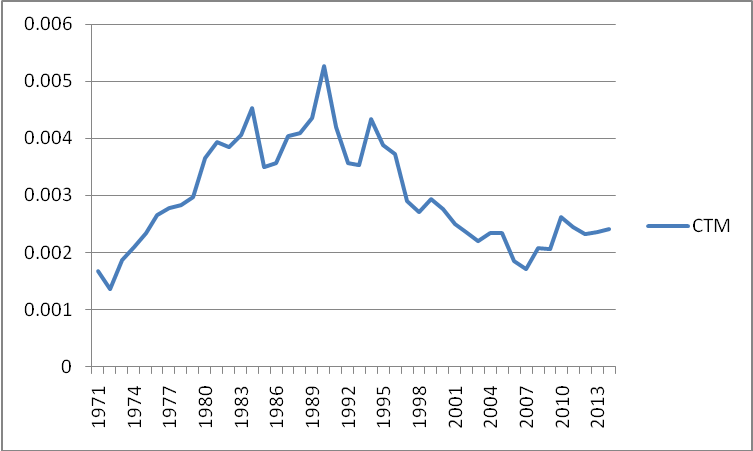
The growth rate of CTM of India declined to -23.45% during 1972, however increased to 27.49% during 1973. During last 44 years the maximum growth of CTM of India stood at 27.49% during 1973 and the minimum growth stood at -29.44 during 1985 (see Fig.1). It has been observed from Fig.1 that out of last 44 years 19 years registered a negative growth rate while all remaining years registered positive growth rate of CTM.
The passenger traffic per aircraft movement (PTM) is obtained by dividing total air passenger traffic by aircraft movement. As explained above, according to World Bank, air passengers carried include both domestic and international aircraft passengers of air carriers registered in the country., whereas the registered carrier departures worldwide, known as aircraft movements are domestic takeoffs and takeoffs abroad of air carriers registered in the country.
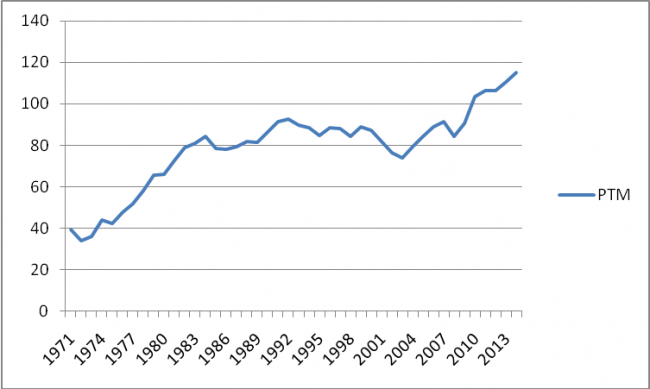
The maximum growth rate of PTM of India as observed from Fig.2 stood at 18.29% during 1974 followed by 12.44% during 2010 and 11.48 during 1976. The year 1972 registered a minimum PTM growth rate of -16.05%. The year 1978 and 1979 registered a PTM growth rate of 10.24% and 11.43% respectively. All the remaining years except the above mentioned years during last 44 year stood at PTM growth of below 9% in India (see Fig.2).
Per capita GDP is the gross domestic product divided by midyear population. During last 44 years Indian economy registered a maximum per capita GDP growth of 8.05% during 2010 and a second highest growth of 7.55% during 2007 (see Fig.3).
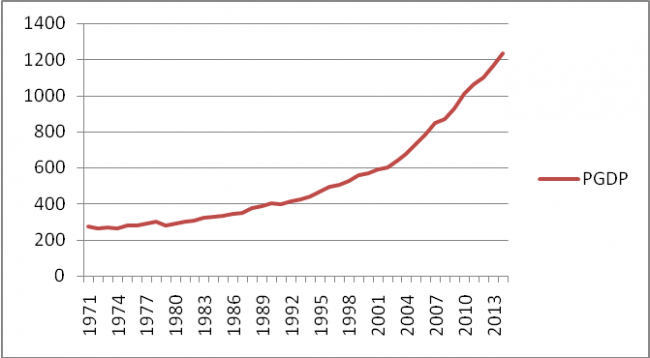
Also Fig.3depicts that during last 44 years Indian economy registered a minimum per capita growth rate of -7.97% during 1979. The years 1972, 1974, 1976, 1979 and 1991 registered negative per capita GDP growth rate and the remaining years registered positive per capita growth rate during last 44 years of Indian economy.
We have considered carbon dioxide emission indicators such as Per Capita CO2 (CO2P), Carbon Dioxide measured in kilotons (CO2K) and Carbon Intensity (CO2I) as proxy variables for environmental degradation in this study. According to World Bank, carbon dioxide emissions are those stemming from the burning of fossil fuels and the manufacture of cement. They include carbon dioxide produced during consumption of solid, liquid, and gas fuels and gas flaring.
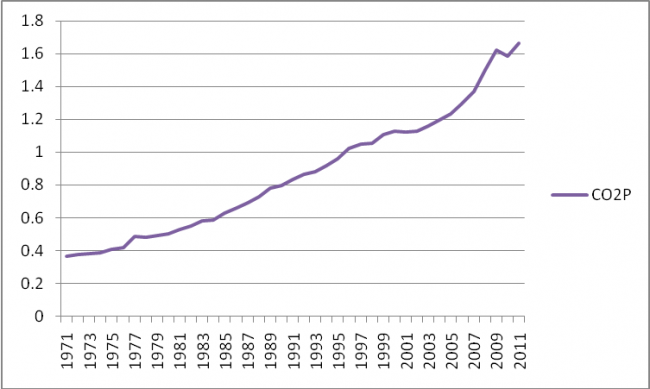
The growth rate of per capita carbon emission (CO2P) as seen from Fig.4 has been rising continuously except few years where the same has registered a negative growth rate. The years 1978, 2001, and 2010 registered negative per capita carbon emission whereas the remaining years registered positive per capita carbon emission growth during last 44 years of the Indian economy. During 1977 the growth rate of CO2P stood at a maximum of 14.51% whereas it registered a minimum growth rate of -2.16% during 2010.

The growth rate of absolute carbon emission measured in kilotons (CO2K) as seen from Fig.5 has also shown a rising trend though it declined during few years. During 1977 the growth rate of CO2K stood at a maximum of 16.44% whereas it registered a minimum growth rate of -0.76% during 2010. The growth trend of CO2P and CO2K remained more or less same during last 44 years though they differ in magnitude due to the former being per capita emission and the latter being absolute emission.
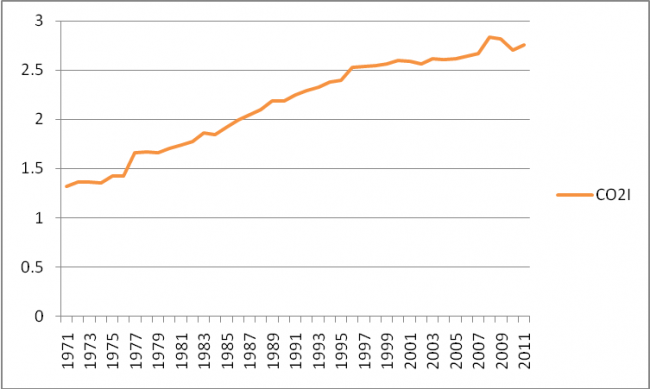
According to World Bank carbon emission intensity is measured as kg per kg of oil equivalent energy use. The trend of growth rate of carbon emission intensity (CO2I) as seen from Fig.6 has also been rising continuously except years 1974, 1979, 1984, 1990, 2001, 2012, 2004, 2009 and 2010 where the same has registered a negative growth rate. The remaining years registered positive intensity of carbon emission growth during last 44 years of the Indian economy. During 1977 the growth rate of CO2I stood at a maximum of 14.11% whereas it registered a minimum growth rate of -4.53% during 2010.
Privatization of Indian airports started in 2000 with the privatization of Cochin International Airport. Subsequently, Bangalore, Hyderabad, Mumbai, Delhi and Nagpur airports were also privatized with PPP mode under BOT approach. The additional four airports are on way to privatization. With the privatization of above mentioned airports, necessity for economic oversight/ regulation was felt and a frame work for this was established in December 2008 by creating Airport Economic Regulatory Authority (AREA). The Airports Economic Regulatory Authority of India Act, 2008 was enacted on 5.12.2008. Under the Act, AERA’s mandate covers determination of tariffs for aeronautical services, user charges and monitoring of set performance standards in respect of major airports. Presently 17 airports in the country has an annual passenger throughput in excess of one and a half million. These 17 airports include 6 joint venture airports and 11 public airports. The other 73 minor airports are regulated by Ministry of Civil Aviation (MOCA), Government of India (Singh, Dalei and Raju, 2015).
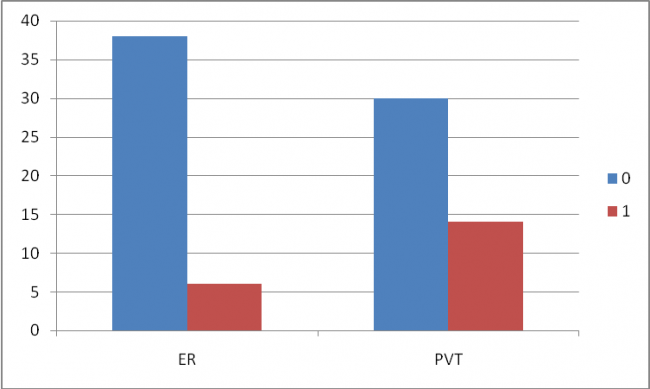
Therefore, in view of this we have introduced two dummy variables viz. economic regulation (ER) dummy and privatization (PVT). The years of aviation activities with presence of economic regulation is coded as one with the frequency of 6 whereas the absence of it is coded as zero with the frequency of 38. Similarly, the years of aviation activities with presence of privatization is coded as one with the frequency of 14 whereas the absence of it is coded as zero with the frequency of 30 (see Fig.7).
4. Impact of Air Traffic and Economic Growth on Environmental Degradation
Airports are generally located in urban areas and cities. Aviation activities directly and indirectly affects natural environment and contribute in its degradation substantially. In this study we have considered various indicator of carbon dioxide as proxy for environmental degradation. Say for example historical data collected from various sources indicates that cargo traffic per aircraft movement in India is significantly and positively affecting per capita carbon emission, absolute carbon emission and carbon intensity. With rising cargo traffic per aircraft movement, per capita carbon emission, absolute carbon emission and carbon intensity are also rising significantly keeping all other factors constant. Passenger traffic per aircraft movement also affects per capita carbon emission, absolute carbon emission and carbon intensity significantly and positively. Passenger traffic per aircraft movement also helps in increasing the per capita carbon emission, absolute carbon emission and carbon intensity substantially and statistically keeping all other factors constant.
Economic growth of Indian economy also affects per carbon emission, absolute carbon emission and carbon intensity statistically and positively, other things remaining constant. That is raising economic growth helps in increasing per capita carbon emission substantially. Economic regulation and privatization each have statistically and significantly negative relationship with per capita carbon emission, absolute carbon emission and carbon intensity other things remaining constant. Implementation of economic regulation has statistically significant influence in reducing per capita carbon emission, absolute carbon emission and carbon intensity. Similarly, introduction of privatization has a statistically significant influence in reducing per capita carbon emission, absolute carbon emission and carbon intensity.keeping all other things constant.Thus, while factors like cargo and passenger traffic and economic growth helps in increasing environmental degradation significantly, public policies like economic regulation and privatization try to reduce it significantly at various statistically significant levels. Therefore, more similar kind of policies must be implemented in India in order to reduce environmental degradation to considerable level. Such an initiative of Government of India is development of Greenfield airports, where the intention is diversion of air traffic from existing airports located in urban areas to outskirt of urban city centers. Many of the airports are either in saturation stage or will be saturated in near future. Therefore, over burden of traffic will generate pollution along with many other problems and the pollution in the environment will be accumulated leading to problem of climate change. Thus development of Greenfield airports will share air traffics of existing airports and the excess pollution will be shifted to outskirt of urban city centers, where its impact will be very less due to natural environment or creation of such environment through plantation.
5. Conclusion
Airports are generally located in urban areas. Aviation activities directly and indirectly affects natural environment and contribute in its degradation substantially. In this study we have considered various indicator of carbon dioxide as proxy for environmental degradation other things remaining constant. Our study finds that cargo and passenger traffic each per aircraft movement is significantly helps in increasing environmental degradation in the country especially in urban areas. Rising economic growth also helps in increasing environmental degradation significantly keeping all other things constant. Economic regulation and privatization have statistically and significantly negative relationship with per capita carbon emission other things remaining constant. While factors like cargo and passenger traffic and economic growth helps in increasing environmental degradation significantly, public policies like economic regulation and privatization try to reduce it significantly at various statistically significant levels. Therefore, more similar kind of policies must be implemented in India in order to reduce environmental degradation to considerable level. Such an initiative of Government of India is development of Greenfield airports, where the intention is diversion of air traffic from existing airports located in urban areas to outskirt of urban city centers. Many of the airports are either in saturation stage or will be saturated in near future. Therefore, over burden of traffic will generate pollution along with many other problems and the pollution in the environment will be accumulated leading to problem of climate change. Thus development of Greenfield airports will share air traffics of existing airports and the excess pollution will be shifted to outskirt of urban city centers, where its impact will be very less due to natural environment or creation of such environment through plantation.
Dr. Narendra Nath Dalei is affiliated with Department of Economics and International Business, University of Petroleum and Energy Studies in Dehradun, India; Prof D. P. Singh is affiliated with Department of Transportation at the University of Petroleum and Energy Studies in Dehradun, India




